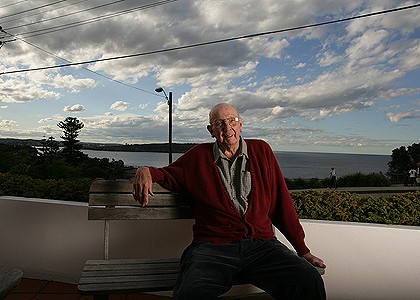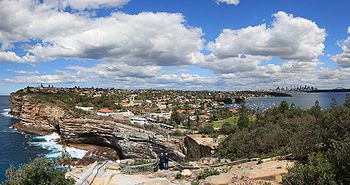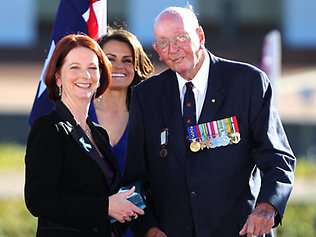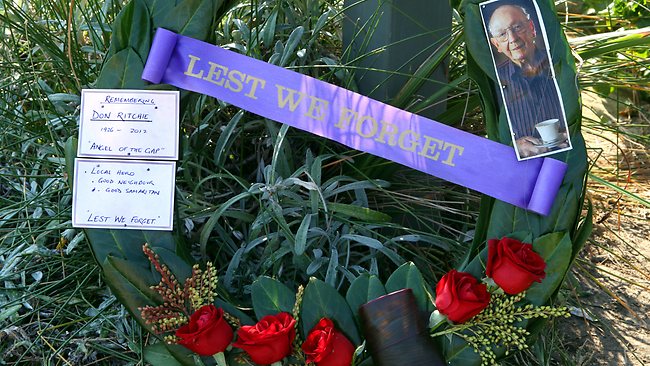
Unlike the hundreds of people over the years, who have committed suicide, by jumping from this notorious, suicide cliff, high above the Tasman Sea, Don Ritchie who was also known as the ‘Watchman’ and ‘Angel of the Gap', passed away peacefully this week, aged 85, surrounded by his loving family and friends. Don is survived by his wife Moya and children Jan, Donna and Sue and his grandchildren.
 For many years, when Mr Ritchie spotted what looked like potentially, suicidal people from his home, he would walk slowly across the road to the cliff-edge where they were often perched, smile and ask them, "Can I help you in some way?" Often this quiet approach worked but if it didn’t then on several occasions, when he was a younger, fitter man, he would even risk his own life, by physically restraining some of the the more determined people, to prevent them from making that final suicidal leap onto the unforgiving rocks below.
For many years, when Mr Ritchie spotted what looked like potentially, suicidal people from his home, he would walk slowly across the road to the cliff-edge where they were often perched, smile and ask them, "Can I help you in some way?" Often this quiet approach worked but if it didn’t then on several occasions, when he was a younger, fitter man, he would even risk his own life, by physically restraining some of the the more determined people, to prevent them from making that final suicidal leap onto the unforgiving rocks below. Afterwards, Don would often invite these people back to his house for a cup of tea and a chat. Some apparently returned years later, to thank him for saving their lives and one survivor gave him a painting of an angel, with the rays of the sun and the simple message: "An angel who walks amongst us."
 Don Ritchie, who was described as ‘a modest man who did not court celebrity or praise’, said that he was all too aware that any publicity could attract more depressed and disturbed people, however he was awarded a Medal of the Order of Australia in 2006 for his services to suicide prevention, he and his wife Moya, were also named 'Citizens of the Year' for 2010 by Woollahra Council and Don Ritchie was named 'Australia's Local Hero' for 2011, in recognition for his brave and inspiring efforts.
Don Ritchie, who was described as ‘a modest man who did not court celebrity or praise’, said that he was all too aware that any publicity could attract more depressed and disturbed people, however he was awarded a Medal of the Order of Australia in 2006 for his services to suicide prevention, he and his wife Moya, were also named 'Citizens of the Year' for 2010 by Woollahra Council and Don Ritchie was named 'Australia's Local Hero' for 2011, in recognition for his brave and inspiring efforts. At the time Don said, "Never be afraid to speak to those who you feel are in need. Always remember the power of the simple smile, a helping hand, a listening ear and a kind word. My ambition has always been to just get them away from the edge, to buy them time, to give them the opportunity to reflect and give them the chance to realise that things might look better the next morning" he said. "You just can't sit there and watch them, you've got to try and save them" even though he believed that ‘‘people will always come here. I don’t think it will ever stop”.
Don recorded some of the deaths in his diary, others he said were eternally etched in his memory. One summer evening, he saw a young man perched on the cliff ledge, beyond the fence. ‘‘I went over and I tried to talk to him, asking him questions about where he was from. He wouldn’t talk much, just kept looking straight ahead. I was talking to him for about half an hour … thinking I was making headway. I said ‘why don’t you come over for a cup of tea, or a beer, if you’d like one?’ He said ‘no’ and stepped straight off the side … his hat blew up and I caught it in my hand.’’ Mr Ritchie later discovered that the 19-year-old had grown up in the house next door to him and had played with his grandchildren. Maybe this young man had been adversely affected by witnessing this sad, endless stream of suicidal people at the Gap cliff edge, just across the road from the house where he himself had grown up? I know from my own experiences as a crisis telephone counsellor and from my university studies that suicide almost seems to be contagious and that it often occurs in clusters.
 To end this blog on a hopefully, slightly happier note, I would like to share this transcript and video by ABC reporter Natasha Johnson, describing how the family of one young woman, then aged 23, called Helen ‘Nellie’ Bishop, who unexpectedly survived her suicidal leap from the Gap in 1923, hope that her story will help to convince people who believe that their life is no longer worth living, that things can as Nellie herself put it, significantly ‘brighten up’ afterwards :-
To end this blog on a hopefully, slightly happier note, I would like to share this transcript and video by ABC reporter Natasha Johnson, describing how the family of one young woman, then aged 23, called Helen ‘Nellie’ Bishop, who unexpectedly survived her suicidal leap from the Gap in 1923, hope that her story will help to convince people who believe that their life is no longer worth living, that things can as Nellie herself put it, significantly ‘brighten up’ afterwards :-The cliffs of the Gap - at the entrance to Sydney Harbour - have long been a notorious suicide spot. And it was here, on the 14 November 1923, a young Helen "Nellie" Bishop came unbearably burdened. The man she loved had returned from the First World War with injuries which would prevent them from having the family she dreamed of.
BILL BRADBURY, NELLIE BISHOP'S GRANDSON: All she ever wanted was to have children. So she was left in a little bit of a quandary. She loved this gentleman but couldn't have children.Here also is one of the original newpaper articles describing Helen Bishop’s desperate suicide leap and her amazing survival and recovery, which was printed in The Northern Miner in November 1923.
NATASHA JOHNSON: At just 23 years old, all seemed lost. But luck intervened.
BILL BRADBURY: Within a millisecond of her jumping, a freak wave has come in from the ocean and rolled in over the rocks below. So instead of hitting rocks, she has actually hit deep water - and as a result of that, she has survived the fall.
NATASHA JOHNSON: Then, a second stroke of luck. Two Italian migrants, Vincenzo and Rosario Dimento were fishing near and rode in to rescue her.
ARTHUR DIMENTO, VINCENZO DIMENTO'S GRANDSON: He heard a sort of a muffled sound and they looked up and they could see someone floating down. They pulled her into the boat. And she was conscious. And they rode around the headland. People organised ambulances and things like that and they just went home. Ha ha! They just went home. Our fishing is finished, let's go home!
NATASHA JOHNSON: It was front-page news at the time. But family members have only known snippets of the story, until now. Nearly 90 years after that fateful day at the Gap, Nellie Bishop's grandchildren - Bill and George Bradbury - met Vincenzo Dimento's grandchildren - Arthur, Vince and Angela - to fill in the blanks.
BILL BRADBURY: Without what happened back then, certainly the two of us and many more wouldn't be standing here.
NATASHA JOHNSON: Bill and George Bradbury's father Bob unearthed the story years ago while investigating the family history, and found newspaper articles - including an interview with Nellie Bishop from her hospital bed.
BILL BRADBURY: "Everything was going against me and the whole world seemed wrong. They say I'm the first one to survive a jump over The Gap. It seems that I am not meant to die yet".
NATASHA JOHNSON: Within a year of the lowest point in her life, Nellie Bishop met and married Lacey Bradbury, a police officer. She went on to have eight children. Five sons followed their father into the force, making ABC News headlines in 1960.
ABC REPORTER: Did you bring much influence to bear to persuade your five sons to join the force?
LACEY BRADBURY, SON OF NELLIE BISHOP: No, I didn't. I just explained the advantages to them.
NATASHA JOHNSON: One of Nellie's sons, Bob Bradbury, became the highest ranking detective in New South Wales. And his two sons, Bill and George, also became boys in blue.
BILL BRADBURY: What you have in the photo here are three generations of police. It is amazing.
NATASHA JOHNSON: Nellie Bishop lived a long, loving and fulfilling life. Pictured here with her eight adult children, she died of natural causes at the age of 88.
BILL BRADBURY: She had a strong will to live. Great personality. Very happy-go-lucky type of lady. We all loved her.
NATASHA JOHNSON: In an ironic twist, her grandson Bill Bradbury became a police negotiator, who often ended up at The Gap talking people out of taking their lives.
BILL BRADBURY: I was able to use that, draw inspiration from it, and indeed, paint the picture that there is hope.
NATASHA JOHNSON: In the Dimento family the story was passed on to a teenage Arthur by an uncle when they were fishing off The Gap. His cousins Angela and Vince knew only that their grandfather had performed an act of bravery, recognised with a certificate that has hung in three generations of family homes.
VINCE DIMENTO, VINCENZO DIMENTO'S GRANDSON: It was always there, not much discussed. But always wondered about. I'm just so proud to be able to show it to you.
NATASHA JOHNSON: The certificate hanging in his hall sprang to mind when Vince Dimento happened to read journalist Peter Fitzsimons's story about Nellie Bishop in the Sydney Morning Herald a few weeks ago.
VINCE DIMENTO: And then I read that article, the date I just got up, yeah. Holy mackerel. I couldn't believe it!
NATASHA JOHNSON: And that's how the Dimentos came to make contact with the Bradburies.
VINCE DIMENTO: I'm so pleased to meet Bill and George and the family. And to see the outcome and... it's really wonderful. I can't believe it.
BILL BRADBURY: We'll certainly keep in touch. You know, because you just can't say thanks enough.
NATASHA JOHNSON: The article triggered the most poignant public response journalist Peter Fitzsimons has had in 25 years. And he's campaigning for a plaque at The Gap telling Nellie's story.
PETER FITZSIMONS, JOURNALIST, SYDNEY MORNING HERALD: On this one, the reaction was phenomenal. Deeply, deeply personal and emotional letters from people who'd lost loved ones to suicide, talking about if only they could've known that story.
NATASHA JOHNSON: Suicide prevention service, Lifeline, says Nellie Bishop's experience is extremely common - pointing to a study of 500 people who were saved from jumping from the Golden Gate Bridge which showed 90 per cent of them went on to die of natural causes.
ALAN WOODWARD, LIFELINE: The problems that seemed so difficult at that time can be addressed, and suicidality is not a lasting situation in their lives. So it's a message of real hope, I think.
NATASHA JOHNSON: Lifeline believes a plaque at The Gap may be counter-productive, but endorses Nellie's family's desire to share her story widely in the hope of saving others.
RAY BRADBURY: People obviously just reach the absolute bowels of their tolerance, their desire, their will to live. And it's actually breaking through that barrier of blackness to see that faint little glimmer of hope that can set them on the right path.
LEIGH SALES: If you need help, or you're worried about somebody else, you can reach Lifeline on 131 114.
TELEGRAMS. HELEN BISHOP'S LEAP. ''THINGS MAY BRIGHTEN UP." SYDNEY, November 14 1923.
Helen Bishop, who made a desperate leap of 200 feet over the Gap at South Head yesterday. In a self-confessed attempt to "end it all." struck out for help after she fell Into the sea, because she was afraid of sharks. She admitted this as she lay In bed in the Sydney Hospital..What caused Miss Bishop to make the leap she is keeping to herself."Everything was going agalnst me, and the whole world seemed wrong" she said. "At last one thing came along, and made me throw myself over the Gap.
I picked the hlghest spot. It was easy to climb through the fence, but even had It been twice as hard, I would have got through somehow. I was desperate. I felt that what I was doing was the best thing, and the only thing. I went to the edge of the rock, and looked down. I did not feel afraid, only determined to end it all- My every act during these few minutes is impressed on my mind in such a manner that I wilt never forget. I jumped, and for a moment lost consciousness, but as soon as I touched the water I became conscious again.
I felt myself sinking down, down, through the water, till I thought I would never come up again, but after what seemed an awful time, I reached the surface again. My first thought was of sharks. I must have forgotten my decision to die, for I struck out" at once towards the rocks. The waves broke over me, and I thought I was going to be dashed on the rocks then I saw a boat with two men and I held up my hand. I am so at home in the water that I just could not let myself drown. The boat came in and picked me up. For a minute or two I was afraid they would be dashed on the shore. Rather than that I hoped they would leave me to die, but they got me in the boat and took me around to Watsons Bay. I felt no pain till I was in the ambulance, when my back began to hurt, now it is very sore, but I don't think It Is broken, because I can more my legs.
I want to get better now. I don't want to die, and I won't try to kill myself again. One experience like that is enough. It seems to me I am not meant to die yet. I think It must be for the best. When I get better I think I Will leave New South Wales. I might do better somewhere else, and things may brighten up." The woman did not give the reason that promoted her to act in such a desperate manner.

Police cameras and emergency phones to crisis counsellors have now been installed at the Gap but unfortunately Don is no longer there to offer desperate, suicidal people a kind word, his helping hand and a cup of tea or glass of beer at his home.
Sources
http://en.wikipedia.org/wiki/Don_Ritchie
http://www.independent.co.uk/news/people/news/australia-mourns-angel-of-the-gap-the-man-who-talked-160-out-of-suicide-7754339.html
http://www.abc.net.au/local/stories/2012/05/14/3502567.htm?site=sydneyhttp://www.smh.com.au/national/an-angel-walking-among-us-at-the-gap-20090731-e4f2.html
http://trove.nla.gov.au/ndp/del/article/80541329?searchTerm=%22helen%20bishop%22&searchLimits=




Comments